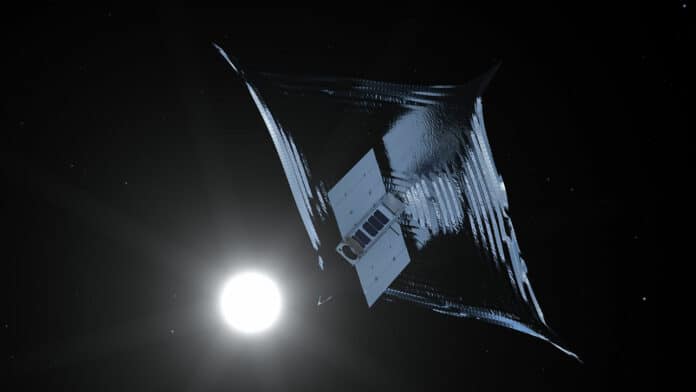Space is getting crowded. The rising space debris population increases the potential danger to all space vehicles, including the International Space Station and other spacecraft with humans aboard.
Much more debris – too small to be tracked but large enough to threaten human spaceflight and robotic missions – exists in the near-Earth space environment. Since both the debris and spacecraft are traveling at extremely high speeds, an impact of even a tiny piece of orbital debris with a spacecraft could create big problems. This put many of Earth’s climate, ocean, and land monitoring missions in harm’s way.
Hoping to pave a cleaner future for our space dreams, the European Space Agency (ESA) has developed an innovative, aluminum-coated sail known as the Drag Augmentation Deorbiting Subsystem (ADEO). The innovative ‘drag sails’ can ride to orbit on satellites and help them deorbit when the time comes.
ADEO is a 38.7-square-foot (3.6 square meters) aluminum-coated polyamide membrane sail that provides a passive method of deorbiting. ESA folded up the sail until it could fit in what essentially looks like a 10-centimeter (4-inch) jack-in-the-box package.
Scientists then attached the ADEO breaking sail to a privately built spacecraft called the ION satellite carrier, which was launched via a Falcon 9 rocket on June 30, 2021.
The sail was then successfully deployed from the ION satellite carrier in late December 2022. The ADEO unfurled, showing its ‘wings’ – a silvery polyamide membrane secured to four carbon-reinforced arms positioned in an X-shape – and immediately initiated the satellite’s descent. The unfurling process was captured by an integrated camera onboard the Ion satellite carrier.
This increases the atmospheric surface drag effect and causes an accelerated decay in the satellite’s orbital altitude. The satellite will eventually burn up in the atmosphere, providing a quicker residue-free method of disposal.
The demonstration technology is attached to a CubeSat, allowing it to come down in a matter of months rather than the years it would otherwise take. The ADEO mission is the final in-flight qualification test needed to provide the technological proof-of-concept.
The European mission, named “Show Me Your Wings,” is the final in-flight qualification test needed to provide the technological proof-of-concept. The ADEO test model is the smallest variation of the ADEO product family, designed especially for the deorbit of small satellites in the 1-100 kg class range.
The approach is, however, scalable for medium and large-size satellites, according to ESA. The largest variation can be as big as 100 square meters and take up to 45 mins to deploy.
ADEO technology provides a safe, robust, and sustainable method of passively deorbiting small satellites. Passive methods of deorbiting are advantageous in eliminating the need for the active steering, with no additional GNC or propulsion subsystem.
